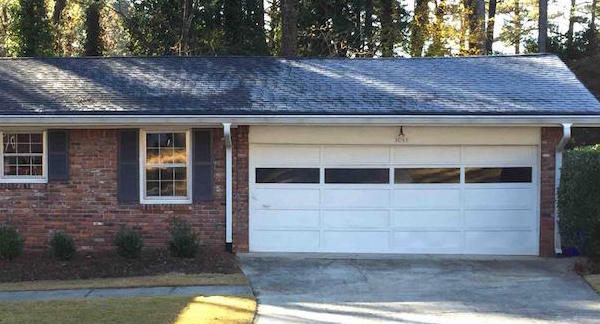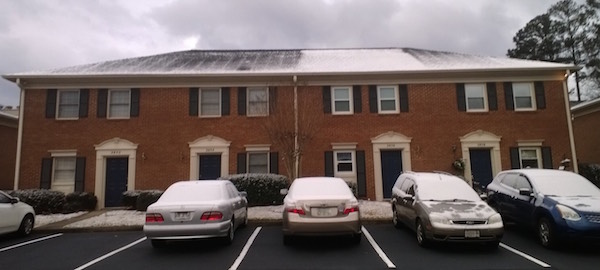A Tale of Two Roofs – Frost, Snow, and Attic Heat Loss

It was the best of times, it was the worst of times, it was the season of cold, it was the season of heat, it was the ignorance of what was right in front of us, it was the opening of our eyes, we had warmth in our homes, we had warmth in our attics — in short, the period was so like the present period that indeed it is the present period, noisy authorities and superlative degrees of comparison aside.
OK, enough of my fake Dickensian prose. Let’s get to the point here. I’ve got two photographs that show the problem with so many homes: ceilings that are porous to heat.
Photograph 1: Warm house, cold garage
I took the photo above on my walk one chilly December morning. Over the garage, you can see the roof is white. That’s frost. Over the living space, the roof has little smatterings of frost but is largely devoid of the frozen stuff.
Why? Because they were running the heat to keep the house warm. Still, why? Because their ceiling isn’t air-sealed or insulated well enough to keep a lot of heat from escaping into the attic. Once in the attic, it warms the air over the living space. That warm air makes contact with the roof deck and warms it up. That heat then conducts up all the way to the shingles.
And here’s the clincher: Warm shingles don’t allow frost to form as readily as cold shingles. Whoa! Science is awesome!
A note about the sharp dividing line: Some people have wondered about that sharp dividing line between the frosty roof over the garage and the not-so-frosty roof over the living space. Surely there must be a partition in the attic that separates those two spaces, they say.
Probably not, I say. I haven’t been in this particular attic, but I’ve been in plenty of other attics of houses of this vintage. I’ve never seen a partition wall up there. [Editor’s note: I asked the homeowner sometime later, and he told there is indeed a wall in the attic. I was wrong.]
What’s happening is that the rafters keep the warm air from migrating much. Notice, though, that there is some migration. Near the ridge the frost-free area extends over the garage a bit because warm air rises and it ends up near the ridge. Some of it can cross the first rafter there, but it doesn’t seem to make it across the second rafter.
Photograph 2: Energy efficient townhome surrounded by inefficient townhomes
I love this photo! Jason Peavey from PV Heating & Air, an Atlanta home performance company, sent it to me this week. We had some snow from the big storm this past weekend, and like frost, it provides some nice visual feedback about heat loss. Can you tell what’s going on here?

PV got the photo from one of their customers, who asked, “Can you tell which unit is mine?”
As with the photo of the house with the attached garage, this one shows a building with two different heat loss regimes. Over that third unit from the left, there’s little heat getting into the attic, as evidenced by the unmelted snow. Over the other units, enough heat escapes into the attics to melt most of the snow. In cold climates that leads to ice dams.
The difference between this photo and the first is that the garage is unheated so there’s just not much heat available to melt the frost on that side in the first photo. In the second photo, the homeowner is keeping his home warm; he’s just not keeping the attic warm as well.
The solution
Some people will tell you that both of these photos prove the need for insulation in the areas where the heat loss to the attic is happening. Not so quick! It could be a simple matter of needing insulation only but most likely these homes also need air sealing. And as you must certainly know (well, you do now anyway), I always tell people, Don’t insulate your attic…until you seal the air leakage pathways.
Allison A. Bailes III, PhD is a speaker, writer, building science consultant, and the founder of Energy Vanguard in Decatur, Georgia. He has a doctorate in physics and writes the Energy Vanguard Blog. He is also writing a book on building science. You can follow him on Twitter at @EnergyVanguard.
Related Articles
Snow on the Roof – The Poor Man’s Infrared Camera
Ice Dam Bandaid Solution: Heat Strips on the Roof
Two Open Doors to the Attic – A Building Science Nightmare
Image credits: First photo by Energy Vanguard. Second photo by PV Heating & Air, used with permission.
Comments are closed.
This Post Has 20 Comments
Comments are closed.

Allison, A much bigger
Allison, A much bigger problem is ice dams in the North. They are hard to prevent with some of the huge snowfalls that occur but the houses that are better insulated and sealed in turn allow less heat to escape to the attic and therefore have less melting of snow. On the poorly sealed and insulated roofs, the snow on the roof melts which in turn freezes at night creating the ice dams.
You’re absolutely right, Bob.
You’re absolutely right, Bob. I’ve written about ice dams a few times and have linked to one of the articles in the list of related articles here. Ice dams are often a result of the same heat loss you see in the photos here but the snow melts and then refreezes at the eave.
As for ice dams and icicles,
As for ice dams and icicles, there were a few cases of people being killed at resorts here in New England in years past. The most common response was to install heat tapes 🙁
Here, here Bob! The biggest
Here, here Bob! The biggest tell-tale I see are icicles hanging from gutters and roof overhangs. After our recent record-breaking snow here in the mid-Atlantic, our house (which I have been working on for over 3 decades) had no icicles and lots of roof snow pack while my next door neighbor had melted patches in the roof snow pack and icicles almost instantly. And you should see some of the historic residences in the region – icicles that extend from the roof edge (2 stories up) to the ground!
That reminds of a story I
That reminds of a story I heard from someone in New Jersey. He said he once saw an icicle on a large house that was so big it fell and totaled a car in the driveway.
The second picture also tells
The second picture also tells you where the (poorly) insulated plane is. The heat escaping from the heated space is seeing the most R value from the rafters. When the roof is insulated it isn’t uncommon to see the reverse, melting along the rafters due to the thermal bridging.
Indeed that’s true, Bill.
Indeed that’s true, Bill. Good point!
That’s a field quiz I often
That’s a field quiz I often use with trainees.
We had about a foot of snow a
We had about a foot of snow a couple of weeks back. I enjoyed looking at a lot of roofs in our neighborhood. All kinds of patterns, from rafters melting first to sections melting. The least amount of melting/most snow left? A guy 3 blocks over who does energy audits for the gas company. Second best? I’m biased but mine. Lots of hours air sealing and insulating last spring has, so far, made a huge difference in ice dams, they were almost totally non existent this year so far. Last year it was bad.
Nice work, Jeremy!
Nice work, Jeremy! Congratulations on the great improvements you’ve made in your attic heat loss. What’s your location?
Northeast Ohio
Northeast Ohio
Thanks all for sharing,
Thanks all for sharing, caring and being dam smart. Avoiding using electric snow melts, helps us all, beyond your property.
Yeah, there are many reasons
Yeah, there are many reasons not to use electric resistance heaters to melt the snow.
There should indeed be a
There should indeed be a separation between garage and dwelling. These are 2 separate occupancies and require a fire separation at least in areas that have or have had a building code enforced. Brings me back to a question that I have been pondering, if I was to remove the loose craft face batting in my 57 Minneapolis rambler and spray foam would that be a good way to seal the attic by pass and if so can that foam go up against the brick veneer of the wood fireplace chimney that runs up the center of the house?
Does spray foam have temperature limitations for ambiant air temperature when it’s installed? Thanks
John, I’m not saying there
John, I’m not saying there shouldn’t be any separation there. I’m saying a lot of houses have been built — and continue to be built — without it.
Yes, spray foam insulation has temperature requirements. It will start discoloring at about 200° F. You don’t want to use it in contact with surfaces that get hot. Use metal to seal the transition to the fireplace and something like mineral wool to insulate that area.
Hi I have heat leaks under my
Hi I have heat leaks under my floors I e hot spots in certain places on wood floors in apartment building we have two pipe steam system with connectors and I believe it’s coming from there any solutions tkx
It depends on exactly what’s
It depends on exactly what’s going on, Bernie, but insulation and air sealing solve heat loss problems, whether they’re in ceilings, floors, or walls.
Allison
Allison
I have a 6,000sf home with geothermal heat pump system and I have 4 x 8 sheathing with aluminum backing. My home is total electric for heating, cooling, hot water, cooking, and of course electric lights using fluorescent lights on 90% of the lighting. My average electric utility bill is $156 per month. The radiant barrier plywood sheathing helps in the summer to keep my attic cool and my home cool,but in the winter it also keeps the attic cool. Could my radiant barrier plywood sheathing be causing me to have higher electric bills in the winter. I live in Stillwater, OK. Thank you!
Gerald, it’s hard to know
Gerald, it’s hard to know whether the radiant barrier roof decking keeps the attic cooler or warmer in winter. On sunny days, it doesn’t let much of the solar heat through, but it will also keep heat that’s already in the attic from escaping. In either case, though, if you have an unconditioned attic, your barrier against heat loss from the home should be at the ceiling level. If it’s airtight and well insulated, the radiant barrier roof deck is irrelevant.
Thanks for all the great info
Thanks for all the great info! I am a novice at this stuff but I love it. After reading this I started looking at my roof in the morning. I noticed the rafters show more frost than the rest of the roof, but not drastically different. Is this normal? Or does this mean I’ve got too much heat in the attic?